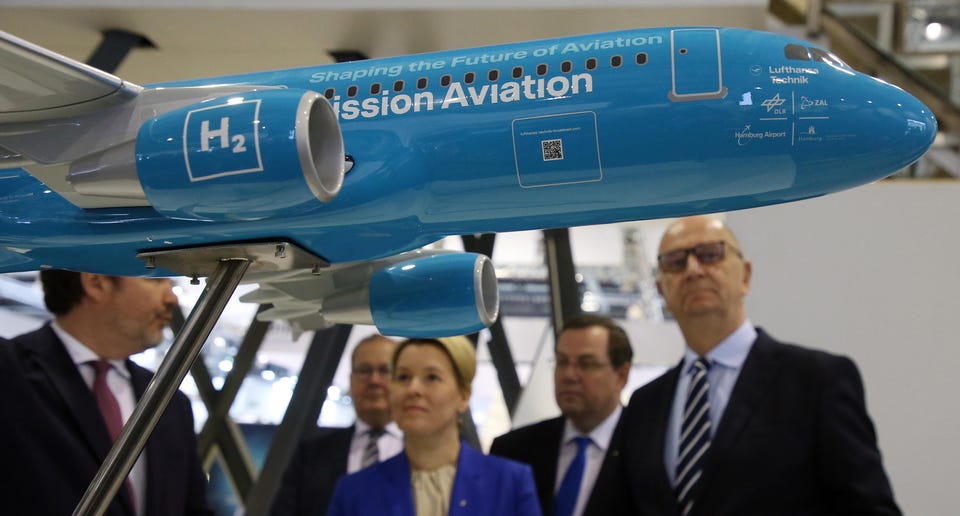Energy Hydrogen Risks Being The Great Missed Opportunity Of The Energy Transition Sverre Alvik Contributor Opinions expressed by Forbes Contributors are their own. I write about key developments influencing the energy transition. New! Follow this author to improve your content experience.
Got it! Jun 24, 2022, 04:41am EDT | Share to Facebook Share to Twitter Share to Linkedin 20 June 2022, Brandenburg, Schönefeld: Franziska Giffey (M, SPD), Governing Mayor of Berlin, and . . .
[+] Dietmar Woidke (r, SPD), Minister President of Brandenburg, stand in front of a model of a hydrogen-powered Lufthansa Technik aircraft during a press tour at the International Aerospace Exhibition (ILA). Photo: Wolfgang Kumm/dpa (Photo by Wolfgang Kumm/picture alliance via Getty Images) dpa/picture alliance via Getty Images From the White House to the boardrooms of Europe, hydrogen is increasingly being seen as an essential element of the energy transition. In the month of June alone: President Joe Biden invoked wartime legislation to direct cash towards the manufacturing of electrolyzers.
The leaders of Egypt and Saudi Arabia agreed to invest billions in hydrogen infrastructure. RWE and ArcelorMittal signed a memorandum of understanding to develop, build and operate renewable energy in order to decarbonize steel production. Volvo showcased its new hydrogen fuel cell truck with a range of 1000 kilometers.
To mention a few. Hydrogen is vital to decarbonizing industries that cannot be easily electrified, like deep sea shipping, aviation, and high heat industrial processes. Yet, our recent forecast Hydrogen Future to 2050 finds that hydrogen uptake will be far too slow.
To meet the Paris Agreement goals, by 2050 hydrogen should meet approximately 15% of energy demand, but our findings show it will reach just 0. 5% by 2030 and 5% by mid-century. Hydrogen Future to 2050 examines the hydrogen industry in detail, but here, I will highlight some of the key findings.
Trillions of dollars in investment Even if hydrogen production is forecast to fall short of what it needs to be, huge investment opportunities exist. Global spend on producing hydrogen for energy purposes from now until 2050 will be USD 6. 8trn, with an additional USD 180bn spent on hydrogen pipelines and USD 530bn on building and operating ammonia terminals.
Global spend on producing hydrogen for energy purposes from now until 2050 will be USD 6. 8trn. DNV MORE FOR YOU Here’s The List Of 317 Wind Energy Rejections The Sierra Club Doesn’t Want You To See Revisiting The Blame For High Gas Prices Why Do ‘Fracking’ Opponents Ignore Its Moral Benefits? Green hydrogen to dominate Electricity-based green hydrogen – produced by splitting hydrogen from water using electrolyzers – will be the dominant form of production by the middle of the century, accounting for 72% of output.
Blue hydrogen and blue hydrogen products like ammonia – produced from natural gas with emissions captured – also have a important role to play, but its competitiveness will gradually reduce as renewable energy capacity increases and prices drop. Green hydrogen production will dominate. Graph from DNV’s Hydrogen Forecast to 2050 DNV Pipelines essential to hydrogen distribution Hydrogen will be transported by pipelines up to medium distances within and between countries, but almost never between continents.
Ammonia – a derivative of hydrogen – is safer and more convenient to transport and is more suitable for long distance seaborne trade. Therefore, we forecast that 59% of energy-related ammonia will be traded between regions by 2050. Hydrogen will not be transported long distances by sea, rather it will be distributed in pipelines.
. . .
[+] Ammonia is more suited for transportation by sea and will traded globally. DNV Natural gas pipelines to be repurposed Cost considerations will lead to more than 50% of hydrogen pipelines globally being repurposed from natural gas pipelines, rising to as high as 80% in some regions, as the cost to repurpose pipelines is expected to be just 10-35% of new construction costs. Whilst new pipelines will be build, more than half of hydrogen pipelines will be repurposed.
Graph . . .
[+] from Hydrogen Forecast to 2050. DNV For planes and ships but not passenger vehicles Hydrogen derivatives like ammonia, methanol and e-kerosene will play a key role in decarbonizing the heavy transport sectors (aviation, maritime, and parts of trucking), but uptake only scales in the late 2030s. We do not foresee hydrogen uptake in passenger vehicles, and only limited uptake in power generation.
Hydrogen for heating of buildings, typically blended with natural gas, has an early uptake in some regions, but will not scale globally. Hydrogen should be treated as a precious resources and only used when no alternatives exist. Uptake .
. . [+] will be focused hard to electrify industries.
DNV Follow me on Twitter or LinkedIn . Check out my website . Sverre Alvik Editorial Standards Print Reprints & Permissions.
From: forbes
URL: https://www.forbes.com/sites/sverrealvik/2022/06/24/hydrogen-risks-being-the-great-missed-opportunity-of-the-energy-transition/



